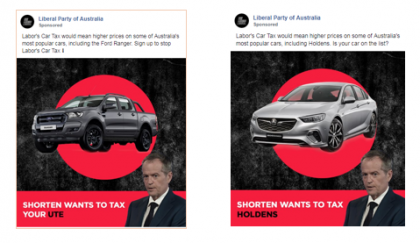Written by: Danielle Stitt
The Liberal party’s win came as a surprise to the pollsters, the bookies and definitely to Bill Shorten.
Headlines are now proclaiming how “inside” polls, social media scraping, and University professors knew all along the Libs would be victorious. So, while others focus on blaming the pundits, we’re going to take a look at which campaign communication tactics did work for the political parties and what financial services marketers can learn from them.After all, elections are the ultimate win/lose power contest – and this a great example of truly integrated PR and marketing – from door knocking to billboards, push polling and social media manipulation.Before election day, the PRIA hosted “Political Campaign Realities: The Eye of the Storm” with Simon Banks and Matthew Hingerty, two seasoned government relations figures. They ran through the major communication tactics both major parties were deploying along with an assessment of what was working and no longer working in 2019. It was evident that the mix of channels was familiar but the execution in those channels was different this time around. (See our blog: How to not bore your audience: creating financial services content people want to read for more on creating interesting content)IRL (in real life)
There’s nothing new in politicians kissing babies and walking down the main street shaking voters’ hands. However, this election saw a rise in volunteer door knocking campaigns, particularly in marginal electorates. For example, local polling indicated that health care was of high importance in marginal electorates, so the Labor Party recruited nurses to visit homes in person to discuss Labor’s plans to boost the health care system.“It was up close and personal.More importantly, it was a compelling way to tell the health care story.Who’s not going to trust a nurse?!”Trust who I know
The role of influencers in consumer brand marketing has now matured to the point it has demonstrated enormous power. Similarly, political parties harness the reach of actively engaged locals who the rest of the community trusts. These locals are identifiable through their attendance at community events, strong voices in suburb-oriented Facebook groups and wielding sway at school’s P&C meetings. With the rest of the population overwhelmed simply getting through the day, we look to these local figures to do their research and form the right opinion. It’s a case of “I trust her, so I’ll have what she’s having.” CMO tip: 30 years-ago the boardroom lunch was a key component of a service’s brand marketing strategy. Slowly these events became overshadowed by the scalability of digital’s reach. Now we’re seeing a swing back to small-scale networking. Perhaps it’s time to dust off the boardroom catering menu and invite your industry’s top networkers to a CEO lunch then let them spread the good word for you. We’ve done so recently for a client and driven direct leads from high net worth investors.Micro before macro
There are two ways political campaigns make micro bets before going big. The first one is to use a low-profile Minister to test a policy with voters and the media. If the message resonates, it’s a winner and becomes a talking point for a higher profile Minister or even the party’s leader. If it bombs, the message dies a quiet death and the party moves on relatively unscathed. It’s about making small bets, learning what works, and only backing the winners.The political parties also used targeted eDMs to test messages with their databases. The engagement with particular articles in the eDM provided rich data for which messages were of importance to their subscribers.Also thinking micro rather than macro, this election saw some targeted social media ads. If you were in the market for a ute, you may well have seen ads by the Liberal Party warning you that Bill wanted to tax your ute. But it gets better. If you were searching for, say, a Holden ute, then the Facebook ad dynamically displayed the Holden ute as Bill’s favourite non-electric vehicle to tax.As an aside, Holden, Toyota and Hilux were NOT happy. CMO tip: Privacy issues aside, social media and particularly Facebook offers precise targeting options which marketers can use to ensure your niche audience sees a highly relevant message. We’ve seen the same – generating high ROI for financial services clients when targeting both B2C and B2B audiences.Related: How to Build an Interesting News Story for Journalists and Their Readers
CMO tip: Privacy issues aside, social media and particularly Facebook offers precise targeting options which marketers can use to ensure your niche audience sees a highly relevant message. We’ve seen the same – generating high ROI for financial services clients when targeting both B2C and B2B audiences.Related: How to Build an Interesting News Story for Journalists and Their Readers
